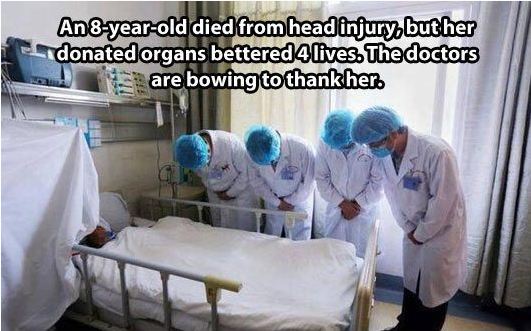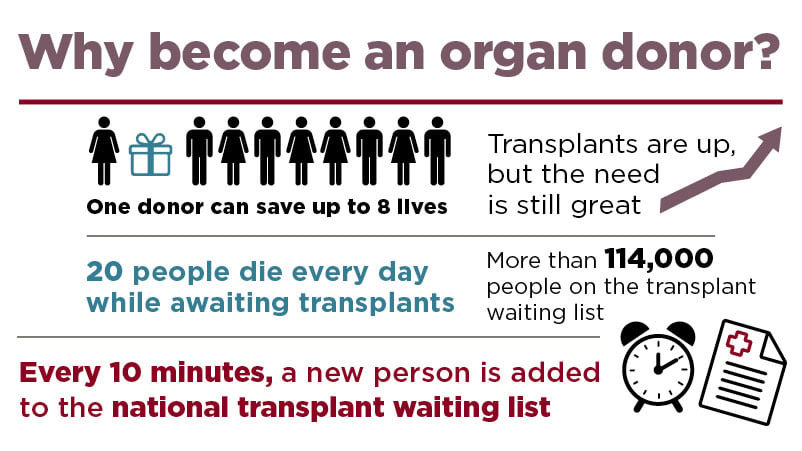Why do people decide not to donate their organs?
Apr 30, 2015 · One donor can impact eight lives That’s right, one single organ and tissue donor can save or improve the lives of more than eight people, helping to restore eyesight, damaged tissues or vital functions. To give an idea of the impact of organ donors, in 2014, there were 29,532 transplants in the U.S. from just 14,412 donors.
What are the arguments against organ donation?
Mar 26, 2021 · “Organ donation can also help the donor family with the grieving process knowing that their loved one is helping save the lives of others.” Dr. Cull shared what you need to know about organ donation. What are the types of organ donation? There are two types of organ donation: deceased organ donation and living organ donation.
What are the pros and cons of organ donation?
Which organs and tissues can be donated after death?

What are 3 benefits of organ donation?
For the Recipient:Quality of life: Transplants can greatly improve a recipient's health and quality of life, allowing them to return to normal activities. ... Increased life span: A kidney transplant dramatically increases the life span of a patient by about 10 years and improves their quality of life.More items...
How does organ donation save lives?
How Donation Saves Lives. One person can save eight lives and enhance 75 others through organ, eye and tissue donation. Nearly 114,000 Americans are currently waiting for an organ transplant, nearly 22,000 live in California. An organ transplant is their only remaining medical option.
How does organ donation affect society?
Donation affects more than the donors and recipients. It also affects the families, friends, colleagues, and acquaintances who love and support those in need of transplantation, and who benefit from their renewed life and improved health after transplant.
What are the advantages and disadvantages of organ donation?
5 Advantages and Disadvantages of Organ TransplantsLife Saver, Facilitator of Better Life. Organ transplant is a life saver, in other words a life giver. ... Furthering Science. Organ transplants are a medical marvel. ... Unmatched Act of Kindness. ... Possible Risks. ... The Uncertain Wait.Jun 28, 2017
Who is the donor of an organ?
In directed donation, the donor specifically names the person who they are donating their organ to such as a biological relative (brother, sister, parent, adult child) or those who are not biologically related, such as a spouse, significant other, friend or coworker.
What are the two types of organ donation?
There are two types of organ donation: deceased organ donation and living organ donation . Deceased organ donation occurs after the donor’s death. In living organ donation, transplant recipients receive their organ from a living donor. Organs that can be donated include heart, lungs, kidney, liver, intestines, pancreas, cornea and tissues.
How many people die from organ failure every day?
About 114,000 people in the United States are currently on the waiting list to receive a lifesaving organ and, on average, 20 people die every day due to the lack of available organs for transplant.
Why do people donate organs?
1. Organ donation is an opportunity to help others . People who are on an organ waiting list typically have end-stage organ disease that significantly impacts their quality of life and may be near the end of their life. Receiving an organ can become a life-changing event for these people.
Why is it important to receive an organ?
Receiving an organ can become a life-changing event for these people. It can also help a family work through the grieving process and deal with their loss by knowing their loved one is helping save the lives of others. 2. The organ waiting list is always long.
Which religions support organ donation?
Most religions support organ donation. This includes Catholics, Protestants, Islam and most branches of Judaism who see it as the final act of love and generosity toward others. If you are unsure, the federal website, OrganDonor.gov provides religious views on organ donation and transplantation by denomination.
How many lives can one organ save?
One organ donor can help multiple people. One organ donor has the potential to save eight lives. 6. Living donors fill a crucial need. A living donor can donate a kidney or a portion of their liver to a friend or family member or even altruistically and continue to live a normal life with very little restrictions.

Organ Donation Day
- Organ Donation Day is celebrated every year on 13 August. That is because people have misconceptions and anxieties regarding organ donation due to a lack of information. This day is organized is to encourage people to donate their organs after death and raise awareness in peo…
Who Can Be An Organ Donor?
- Anyone, irrespective of background, gender, region, locality, or present or previous medical issue, can decide to be an organ donor. As for the age, even the young ones can sign up as an organ donors. That is, as long as they are healthy and so are their organs, learn more about this in-depth here, “Who can donate?”
Organ Donation Process
- Even though vast numbers of people have signed to be organ donors, only a few donors die in a way that allows for organ transplants. And there are lots of things you need to get through to become a certified organ donor. Read more about this here: What’s the organ donation process after death?Here are some more facts about the organ donation procedure:
Reasons Why Organ Donation Is Important
- Why is organ donation important? With the drastic innovation in the medical field, almost any organ and tissue can be repaired and renewed through organ transplant, and this procedure needs organ donation. That is why it is essential. On the other hand, you’d want to learn what power red blood donation is. Here are a few reasons due to which organ donation has vital importance: 1. …
Conclusion
- Indeed, Organ donation means donating life to others. Do you want to know why is organ donation important? Yes! Organ donation is extremely beneficial to the mourning process. Moreover, some donor relatives find solace and comfort as a result of organ transplants. Thus, the transplant can improve many people’s lives through organ donation. My friends, I hope you all understand the i…
Popular Posts:
- 1. what organs can you donate while still alive
- 2. how to set donate page ulx
- 3. how to donate body for medical research
- 4. when people donate to start a library where do the books come from
- 5. how much does it cost to donate eggs in fl
- 6. how much money does dolly parton donate
- 7. what can you donate at goodwill
- 8. where to donate gems
- 9. where to donate formula near me
- 10. where to donate bone marrow for money in orange county ca